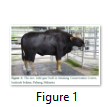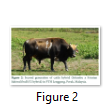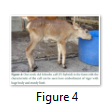Full Length Research Article
Production and Growth Performance of Malayan Gaur x Cattle Hybrid (Selembu) in Malaysia
Mohd Iswadi Ismail1*, Fazly Ann Zainalabidin1, Abdul Samad Akil1, Mohd Hafiz Mail1, Zawawi Ismail2, Abdul Wahid Haron3, Abas Mazni Othman4
Adv. life sci., vol. 6, no. 1, pp. 19-23, November 2018
*- Corresponding Author: Mohd Iswadi Ismail (Email: iswadi5@yahoo.com)
Authors' Affiliations
2- National Institute of Veterinary Biodiversity, Department of Veterinary Services, Bukit Dinding, 27000 Jerantut, Pahang, Malaysia
3- Department of Veterinary Clinical Studies, Faculty of Veterinary Medicine, Universiti Putra Malaysia, 43400 Serdang, Selangor, Malaysia
4- Malaysian Agricultural Research and Development Institute (MARDI), 43400 Serdang, Selangor, Malaysia
Abstract![]()
Introduction
Methods
Results
Discussion
References
Abstract
Background: In 1980s, the first gaur x cattle hybrid (Selembu) was born in Malaysia. However the production and domestication of the animal faces many obstacles. The aim of this literature is to report the potential concept for introduction and production of Selembu through hybridization program in Malaysia. Data generated from this study will be useful to strengthen the concept for the production of Selembu for the benefit of the beef industry as well as conserving the genetics of the gaurs in the wild.
Methods: Fresh semen was collected from three wild matured Malayan gaur bulls by TM-EEJ technique. The collected semen were evaluate for volume, motility, viability and concentration before undergo cryopreservation. Data on semen collection, analysis and cryopreservation were used as criteria for semen selection during AI into the cow. The conception rate was recorded in each inseminated group. Selembu calves were raised and evaluated their growth performance in farm environment.
Results: As a result, we managed to collect and cryopreserve the semen from all three wild gaur bulls. The cryopreserved semen was thawed and insert into cows by AI technique. 13 out of 21 cows in the farm received the gaur semen successful pregnant with Selembu fetus.
Conclusion: An improvement in farm management, animal husbandry, breeding program and conservation of wild gaur would benefit the production of Selembu in the future.
Keywords: Malayan Gaur x cattle hybrid, Artificial insemination
In 1983, Malaysia saw the first birth of interspecies hybrid called Selembu (Malayan gaur x Friesian Sahiwal) through chance mating in the dairy farm of Malaysian Department of Veterinary Services, Kluang, Johor, Malaysia [1]. It resulted in the birth of 12 Selembu (F1 hybrids) calves, the first in the world. Since then, a number of Selembu were produced by natural mating of the gaur bull with dairy cows until the program was stopped due to the death of the gaur bull in early 1990 [2]. Instead of using the dairy cattle by natural mating, Malaysia had produced the Selembu cattle through hybridization of gaur and crossbred cattle (Bos gaurus x Bos indicus/Bos taurus) by natural mating and artificial insemination [2].
Biologically, Selembu displayed a unique physical feature from both; gaur and cattle characteristics, such as body conformation, coat colour, horns and spinous process which can be used for identification purposes [3]. The Selembu was reported as showing embodiment of vigor with huge body, sturdy limbs, superior growth performance as compared to their cattle parent at all life stages and had coat color of black with brown patches on the forehead and along the midline [4]. Its sire, wild Malayan gaur can be identified with their whole body covered with dark brown coat, lower legs have white to tan in colouration and weight over 1000kg in male and 700-800kg in female (Figure 1). In both sexes, the horns grow from the sides of their head and curving upwards. A bulging grey-tan ridge can be seen on the forehead connecting the horns and the forehead. Shoulder humps are present in adult males but none in adult females [5]. Naturally, the gestation period of the gaur is about 310-314 days and normally, adult female gaur gives one calf per pregnancy [6]. Genetically, the Selembu have a chromosome complement 2n=58 which is intermediate between gaur (2n=56) and cattle (2n=60) [1,7]. Even though the chromosome of the Selembu is different from their sire and dam and an earlier assumption that the Selembu bulls are sub-fertile, recent studies on the fresh semen evaluation of the Selembu bull shows only 10-20% lower which is not significant as compared to fresh semen from Malayan gaur, which indicate that the semen from Selembu bulls still have the ability to produce calf for their next generation or the semen can be used in future breeding program [8]. The hypothesis was supported and proved by the birth of second generation (F2) of cattle hybrid (Selembu x Friesian Sahiwal) through back crossing between the Selembu bull and cattle (Figure 2) [1]. Interestingly, the chromosome complement of the F2 of the cattle hybrid was 2n=60 which is similar to the cattle chromosome. The characteristics of the F2 cattle hybrid were seen close to cattle with minimal features of the gaur. Further investigation should be done on the genotype, phenotype, behavior and fertility status of Selembu.
Therefore, the aims of this study are; i. to evaluate the semen collection, analysis and cryopreservation from wild Malayan gaur bulls, ii. To determine the conception rate of cows received semen of gaur bulls in the farm environment, and iii. To observe survival rate and growth performance of Selembu in the farm environment.
Collection, analysis and cryopreservation of Malayan gaur semen
On careful work, the semen of three wild Malayan gaur bulls in Seladang Conservation Center, Jenderak Selatan, Pahang, Peninsular Malaysia were collected, analyzed and cryopreserved in liquid nitrogen. In this study, the semen was collected by combination of transrectal massage-electroejaculation (TM-EEJ) technique. Immediately after collection, the volume of each sample was measured in a graduated test tube. The progressive motility and sperm concentration were evaluated under a light microscope at 100x magnification using glass slide and Makler counting chamber (Sefi-Medical Instruments Ltd, Israel). Then, each semen sample was gently added with the Bioxcell® medium (IMV Technologies, France) to provide nutrients and contains cryoprotectant agent (CPA) to extend the longevity of the bull sperm during the cryopreservation process and tris-citric egg yolk extender, before proceeding with cryopreservation process. After added with the extenders, the semen was then transport in special container containing warm water adjusted temperature of 37±0.5°C until reach the laboratory. Once arrived at the laboratory, the semen was kept in the cooling cabinet at 4°C for 4 hours to prevent the cold shock injury to the sperm during cryopreservation process. The semen was then cryopreserved in liquid nitrogen using slow freezing technique after the semen was filled in 0.25 ml cryo-straw. Briefly in slow freezing technique, the straws were kept above liquid nitrogen for evaporation process from -60°C to -120°C for 9 minutes before plunged into the liquid nitrogen to minimize the ice crystal formation. The cryopreserved semen was thawed at 37°C for 60 seconds. Fresh and post-thawed semen were analyzed in the laboratory. Sperm concentration and motility was evaluated using the Makler counting chamber, sperm viability and morphology was determined using eosin-nigrosin staining protocol. At least 200 sperms were assessed for each preparation.
Artificial insemination (AI) using cryopreserved Malayan gaur semen
Forty Kedah-Kelantan crossbred cows with average body condition score of 3 according to scale of 0 (most emaciated) to 5 (fattest) and anatomically normal reproductive tracts were used for AI with Malayan gaur semen. Estrus synchronization was done on all cows using CIDR® (Controlled Intravaginal Drug Release, Pfizer Inc., New Zealand) for 8 days. After CIDR® was removed 2ml of cloprostenol sodium (Estrumate®, Schering-Plough Pty Ltd., Australia) were injected intramuscularly. AI was carried out using frozen-thawed Malayan gaur semen on the cows which show signs of estrus after 48 hours of CIDR® removal. AI was done twice at 12 hours interval. On the other hand, AI was repeated in cows which show natural estrus signs (after 18 to 21 days of estrus synchronization).
Semen collection, analysis and cryopreservation
As a result, semen from all three Malayan gaur bulls was successfully collected by TM-EEJ technique. An observation during TM-EEJ, the gaurs show musculoskeletal movement consisted of hind limb extension and pelvic thrusting which is typical for that seen by using EEJ. All Malayan gaur in this study achieved an erection. There was no evidence of rectal trauma by applying TM-EEJ technique in all those three Malayan gaur bulls. Analysis on the quality of ejaculated semen shows variable results. Fresh semen collected shows volume in ranges from 0.2 ml to 11.0 ml, pH level in collected semen range from 6.58 to 8.42, progressive motile sperm has been seen ranging from 16% to 70%, viable sperm about 86% and normal morphology of 87.5%. Analysis on the post-thawed semen show progressive motility decrease in the range of 10% to 40%, viable sperm about 64% and normal sperm morphology was about 87%.
Birth, survivability and growth performance of Selembu in farm
Thirteen out of 21 cows was detected pregnant during pregnancy diagnoses by rectal palpation at 60-day gestation period after inseminated with frozen-thawed Malayan gaur (Bos gaurus hubbacki) semen by AI technique (Figure 3). During gestation period, one cow had early abortion at 135 days. The gestation periods observed on the other pregnant 12 cows were found in the range of 282 to 301 days after AI. The gestation period in Kedah-Kelantan crossbred cows pregnant with Selembu fetus was found comparable to the gestation period of beef cows (279 to 292 days) and gaur (310 to 314 days). Twelve cows successful gave birth to 12 healthy Selembu calves (Figure 4). However, due to complication during birth, 3 calves died less than 2 weeks after birth and 9 Selembu calves managed to survive. As a result 69% survival rate of the Selembu calves were recorded.
The survived Selembu calves were evaluated for their weight and growth performance. Results showed 12 Selembu calves were delivered with birth weight ranging from 16 kg to 29 kg (average weight of 22.3 kg). Later, continuous measurement of body weight for the 9 Selembu calves every 14 days up to 84 days was conducted to analyse their growth performance. The highest growth rate for Selembu calves was recorded at 0.92 kg/day and the lowest was 0.14 kg/day with an average daily weight of 0.62 kg/day.
Tables & Figures
In bulls, semen quality is dependent on many factors, including seasonal changes, sexual activity and individual variability [8]. Success in collection, analysis and cryopreservation of limited amounts of wild Malayan gaur semen is very challenging [9]. To our knowledge, very limited documents reported on collection, analysis and cryopreservation of Malayan gaur semen. Therefore, further advances in optimizing the collection, analysis and cryopreservation of Malayan gaur semen were required to improve the utilization and storage of the collected semen. In this study, attentions were given on the very small volume of Malayan gaur semen collected, method of semen collection and minimize the effect of cryopreservation process on the sperm.
Even though, sperm motility, viability and morphological changes of the post-thaw semen of Malayan gaur were found undesirable due to the complication of the cryopreservation process, ice crystal formations and temperature changes. Results of sperm motility, viability and morphology obtained in this study were comparable with a previous study and found acceptable to be used in artificial insemination program [10].
In Malaysia, AI had a tremendous effect in both dairy and beef industries. At least 10% of the breeder female cattle in Malaysia need to be mated with superior breeding stock through AI in up-scaling the cattle production [8]. Through AI, crossbred cattle with higher productivity were able to produce, with being reasonably adjusted to the tropical environment and sufficiently disease resistant as compared to the pure temperate breeds. In applying the AI, it was found able in sustaining the production of dairy and beef crossbreds, thus will improve socioeconomic status of farmers. AI is inexpensive, useful for grading up to get pure-bred animals, has low disease transmission risk and allows passive immunity from native dams [8]. Therefore, AI has and will continue to be an important technology for cattle farming.
Current thinking on beef industry using wildlife animals must also consider the genetic conservation program of the animal itself. Improving the management system with regards to feeding and husbandry would result in increase of the number of Selembu in farms and gaurs in wild. By improving several aspects in animal breeding management program includes synchronization of estrus, improvement of semen collection, semen evaluation and cryopreservation, genetic studies and increase the use of assisted reproductive biotechnologies could be beneficial in producing a large volume of Selembu production. On the other hand, previous report showed that Selembu were able to be identified and differentiated from cattle or gaur rapidly using readily optimized PCR and PCR-RFLP methods [11,12].
Selembu is unfamiliar to international animal science. Therefore, kindle awareness of their possible promise and to stimulate their introduction into domestic farms with regards to local species will create the long-term success of livestock breeding program in the future. Data generated from this study will be useful in accelerating the animal production, thus will increase the beef industry capacity as well as conserving the genetics of the gaurs in the wild. Improvement in farm management and animal husbandry would benefit the use of Selembu as meat alternative in the future.
Based on the data obtained from this study, we conclude that; i. wild Malayan gaur bull semen can be collected by TM-EEJ technique with no evidence of rectal trauma, ii. Optimization of the process of cryopreservation for Malayan gaur semen is needed to maintain the cryo-viability of the good sperm quality, iii. Beef cow in the farm can be used as a suitable dam for Selembu production with more than half of experimental animals able to pregnant following AI, iv. Survival rate and growth performance of Selembu calves in the farm were very good.
Conflict of interest
The authors declare that there is no conflict of interest regarding the publication of this paper.
The authors would like to acknowledge Ministry of Science, Technology and Innovation (MOSTI) for providing research grant (06-05-ABI AB 003) to support this study and also the Department of Wildlife and National Parks, Peninsular Malaysia for their help and support.
- Mamat-Hamidi K, Idris I, Hilmi M. Karyotype of Malayan gaur (Bos gaurus hubbacki), Sahiwal-Friesien cattle and gaur x cattle hybrid backcrosses. Pakistan Journal of Biological Science, (2009); 12: 896-901.
- Azman NN. Malaysia's new hybrid animal-Selembu. Proceedings of the 7th Congress of the Federation of Asian Veterinary Associations, Royal Thai Veterinary Medical Association, Bangkok, Thailand, (1990); 856-858.
- Department of Veterinary Services, Ministry of Agriculture Malaysia. First report on the state of the world’s animal genetic resources: Animal genetic resources in Malaysia, FAO, (2003); 82-82.
- Azman NN. Performance of gaur x cattle hybrids. MSc Thesis, Malaysia: Universiti Pertanian Malaysia, Serdang (1989).
- Department of Wildlife and National Parks, Peninsular Malaysia. Seladang (Bos gaurus) di Semenanjung Malaysia. Kertas Informasi Seladang. Retrieved from http://www.wildlife.gov.my, (2009); accessed on 25 January 2018.
- Ministry of Natural Resources and Environment, Malaysia. Seladang. In: e-Buletin NRE Edisi Sept-Okt 2011, (2011); 11.
- Maslinda M, Shu-San L, Fazly Ann ZA, Shaharum S, Khairiah MS, Zainal Zahari Z, Abas Mazni O. Karyotype of the Malayan gaur (Bos gaurus hubbacki). Proceeding of the 31st Malaysian Society of Animal Production Annual Conference, Kota Bharu, Kelantan, Malaysia, (2010); 190-191.
- Raymond AK, Saifullizam AK. The cattle artificial insemination industry in Malaysia. Malaysian Journal of Veterinary Research, (2010); 1(1): 1-7.
- Iswadi MI, Fazly Ann Z, Hafiz MM, Hafiz MD, Fahrul FJ, Hajarian H, Abdul Wahid H, Zawawi I, Khairiah MS, Abas Mazni O. Collection, analysis and cryopreservation of semen from Malayan gaur (Bos gaurus hubbacki): A preliminary study. Open Veterinary Journal, (2012); 2: 109-114.
- Iswadi MI, Hafiz MM, Fazly Ann ZA, Hafiz MD, Romaino SMN, Shu-San L, Fahrul, FJ, Zawawi I, Abas Mazni O. Analysis of fresh ejaculated semen from Malayan gaur (Bos gaurus hubbacki). Proceeding of the 31st Malaysian Society of Animal Production Annual Conference, Kota Bharu, Kelantan, Malaysia, (2010); 164.
- Rosli MKA, Zamzuriada AS, Syed-Shabthar SMF, Mahani MC, Abas Mazni O, Md-Zain BM. Optimization of PCR conditions to amplify Cyt b, COI and 12S rRNA gene fragments of Malayan gaur (Bos gaurus hubbacki) mtDNA. Genetics and Molecular Research, (2011); 10(4): 2554-2568.
- Romaino SMN, Fazly Ann Z, Shu-San L, Hafiz MM, Iswadi MI, Abas Mazni O. Rapid identification of Selembu species by using PCR-RFLP method. Proceeding 32nd Malaysian Society for Animal Production Annual Conference, Tawau, Sabah, Malaysia, (2011); 107-108.
This work is licensed under a Creative Commons Attribution-Non Commercial 4.0 International License. To read the copy of this license please visit: https://creativecommons.org/licenses/by-nc/4.0








